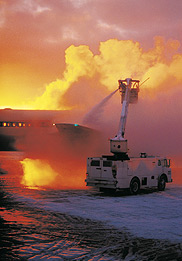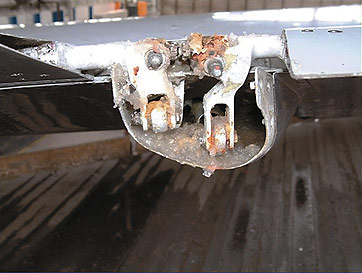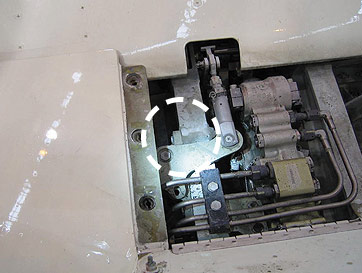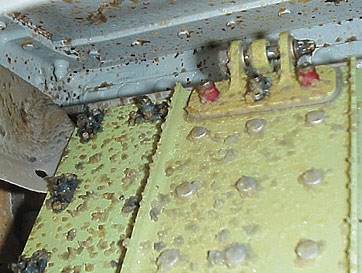
 |
Airplane deicing and anti-icing fluids can leave residue in critical areas in the wings and stabilizers. This residue can rehydrate and expand into a gel-like material that can freeze during flight and cause restrictions in the flight control systems. Therefore, attention to this residue should be part of a regularly scheduled inspection and cleaning process. Additionally, industry experience has shown that using a two-step deicing/anti-icing process helps to reduce the amount of fluid residue that forms in the wings and stabilizers. |
| RESIDUE FROM DEICING/ANTI-ICING FLUID IS AN INDUSTRY-WIDE ISSUE THAT AFFECTS A VARIETY OF AIRPLANE MODELS . | by Joel Hille, Lead Engineer, Boeing Service Engineering |
Operating airplanes during winter conditions can be very challenging. Removing ice, frost, or snow is obviously a requirement for safe airplane operations. But the use of thickened deicing/anti-icing fluids to allow takeoff during active snowfall adds another dimension to winter operations: Although these fluids have undoubtedly made winter operations safer, they have also been known to cause problems that may degrade the airworthiness of an airplane. This article provides insight into these problems and how to resolve them. It includes:
- Overview of deicing and anti-icing fluids and fluid residues.
- Differences in deicing and anti-icing practices between Europe and North America.
- Interaction of airplane fluids and runway fluids.
- Inspection and cleaning recommendations.
- Industry actions.
OVERVIEW OF DEICING AND ANTI-ICING FLUIDS AND FLUID RESIDUES
One of the most significant consequences of winter operations is the need for ground application of deicing and anti-icing fluids to protect against performance degradation due to snow, ice, or frost in critical locations on the airplane. When these fluids are properly used and applied, they will maintain the airplane in the approved configuration for takeoff and safe flight. However, events in recent years have shown that residue from thickened deicing/anti-icing fluids (Types II, III, or IV) can remain in aerodynamically quiet areas and accumulate over time.
During suitable weather conditions, this residue can rehydrate and form into a gel-like substance that swells to many times the original size. The residue gel can freeze during flight, and if located in areas of flight control components and linkages, control surface movement may be restricted, which could result in airplane controllability issues on one or more of the flight axes (see figs. 1–3). Accordingly, airplanes exposed to deicing/anti-icing fluids should be subjected to periodic inspections for fluid residue, and any residue found should be removed. Failure to do so may degrade the airworthiness of the airplane.
 |
Figure 1
Anti-icing residue gels can freeze during flight, causing interference with flight control linkages and surfaces, such as these MD-90 elevator tab control rods. |
 |
RESIDUE GEL UNDER INPUT LINK
Figure 2
Residue gel under the input arm of the MD-90 elevator power control unit interfered with the pilot input, making the restriction evident to the pilot through the control column feel forces. |
 |
Figure 3
Residue in gel form on the elevator balance panel of a 737-800 airplane. |
During the last two winter seasons there have been reports of impaired flight controls on airplanes operating throughout the European region. These reports have involved regional and commuter airplanes as well as small commercial jetliners. The events have occurred on both types of airplanes — those that have hydraulically powered flight control systems and those that have nonhydraulically powered flight control systems. The events are more common on smaller airplanes because, during severe winter weather, small- and medium-sized airplanes may receive many fluid treatments every day, increasing the possibility of anti-icing fluid residue accumulation.
The wide variety of airplanes that have been affected makes it clear that deicing/anti-icing fluid residues are an industrywide issue. Airplanes from several different manufacturers have experienced in-flight control issues that have resulted from the presence of residue gel. In several cases, it was determined that the residue had been generated from fluids that were applied during previous winter seasons. Although Type III fluids have not been specifically linked to any events involving flight controls, the composition of these fluids makes them equally susceptible to residue problems as the Type II and Type IV fluids. It is important to note that Type III fluids have only been commercially available for a short time, and on a limited basis, which is likely the reason they have not caused any known residue problems so far.
It is also important for operators and/or their service providers to take steps to ensure that all deicing/anti-icing fluids are being stored and handled properly in accordance with the fluid manufacturers’ recommendations. Improper storage and use could result in degraded fluid performance or the use of greater volumes of fluid, which could contribute to the formation of more residue. For example, spraying fluid from the rear of the wing rather than from the front, which is the correct method, might result in more fluid entering the flight control areas through the control surface vent gaps.
As a result, it is important for all operators to realize that keeping airplanes safe for winter operations now involves more than inspecting for snow or ice on the wings and stabilizers and treating the airplane with deicing/anti-icing fluids. It also involves inspecting for and removing deicing/anti-icing fluid residues in hidden places in the wings and stabilizers.
